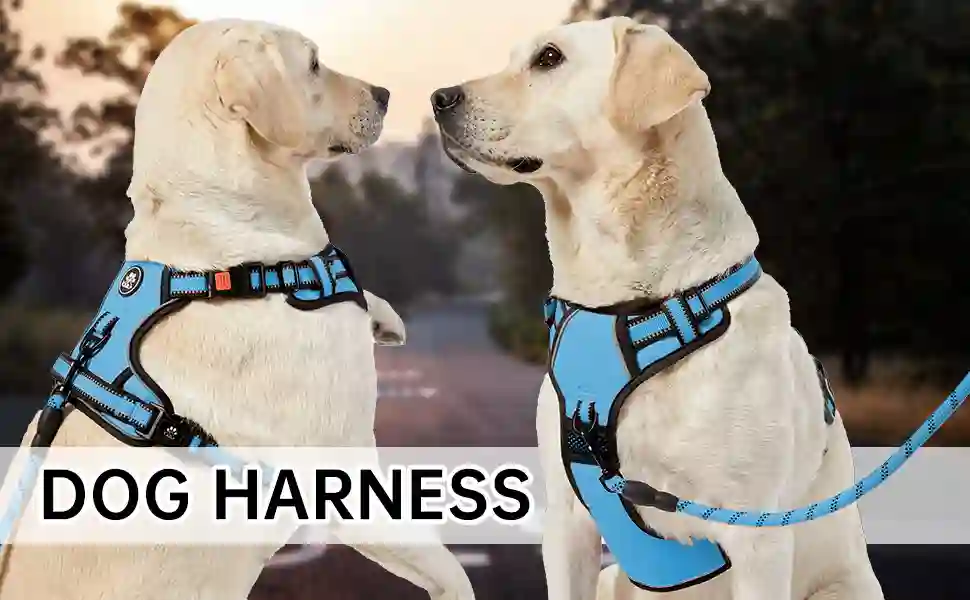Types of Dog Harnesses: Which Is Best for Your Pup?
- 781 Views
- Nicholas Éric
- January 8, 2024
- Safety & Security
Choosing the right harness for your dog is crucial for both their comfort and safety. With the plethora of options available in the market, selecting the most suitable one can be overwhelming. Each type of harness serves a specific purpose, and understanding these differences will help you make an informed decision. In this article, we will delve into various types of dog harnesses, their features, and their suitability for different dogs.
1. Back-Clip Harness
The back-clip harness is one of the most common types. It features a leash attachment on the back and is ideal for small dogs or dogs with delicate throats that might be prone to injury from collars. They are also great for well-trained dogs that do not pull on the leash, as this type of harness does little to discourage pulling. The ease of use makes it a popular choice among pet owners.
2. Front-Clip Harness
Front-clip harnesses have the leash attachment in the front, over the dog’s chest. They are designed to reduce pulling and offer better control over your dog’s direction, making them a good choice for training purposes. However, the leash can sometimes get tangled under the dog’s front legs if they move a lot. These harnesses are excellent for dogs that tend to pull or are in the process of leash training.
3. Dual-Clip Harness
Offering the best of both worlds, dual-clip harnesses have attachments on both the back and the front. This versatility allows the owner to switch between attachments based on the training needs or walking style of the dog. They are ideal for owners who want a multifunctional harness that adapts to various situations, from relaxed walks to training sessions.
4. Step-In Harness
As the name suggests, your dog steps into this type of harness. It typically clips up on the back and is particularly suitable for small dogs or dogs that don’t like things being put over their heads. Step-in harnesses are generally easy to put on and take off but might not provide as much control as front- or back-clip harnesses, making them less ideal for large or strong dogs that pull.
5. No-Pull Harness
Designed specifically to discourage pulling, these harnesses usually have a martingale loop or other feature that tightens slightly when the dog pulls, applying gentle pressure to discourage the behavior. It’s important to use these harnesses correctly and humanely, ensuring they fit well and the pressure is minimal and not causing any discomfort to the dog.
6. Tactical Harness
Tactical harnesses are built for durability and functionality. They often come with heavy-duty materials, handle grips for control, and attachment points for gear and patches. These are ideal for working dogs, dogs that go on hiking or camping trips, or for owners who need a more rugged, utility-focused harness.
7. Adjustable Harness
Almost all harnesses have some level of adjustability, but certain designs emphasize this feature, offering a wide range of fit adjustments. These are especially useful for growing puppies, dogs between standard sizes, or breeds with unique body shapes. Adjustable harnesses provide a customizable fit that can be altered as needed.
8. Vest Harness
Vest harnesses are more about comfort and style. They often come in various colors and patterns and are made with soft materials. The coverage provided by a vest harness distributes pressure more evenly, which can be more comfortable for the dog. These are suitable for small to medium-sized breeds that don’t have heavy pulling tendencies.
9. Padded Harness
Padded harnesses offer extra cushioning on the straps to prevent rubbing and discomfort. They are excellent for dogs with sensitive skin, long-haired breeds, and dogs prone to irritation from straps. Padded harnesses are also preferred for more active dogs as they provide additional comfort and protection.
10. Harness for Special Needs Dogs
Some harnesses are designed specifically for dogs with special needs, such as those with mobility issues, injuries, or senior dogs. These harnesses might include additional support features, like lifting handles, to aid in moving the dog.
Choosing the Right Harness
When selecting a harness, consider the following factors:
- Dog’s Size and Breed: Larger, stronger dogs might require a more robust harness for adequate control, while smaller dogs benefit from a lightweight design.
- Behavior and Temperament: If your dog is a puller or jumper, a no-pull or front-clip harness might be more suitable.
- Comfort and Fit: Ensure the harness fits snugly but isn’t too tight. You should be able to fit two fingers under any strap.
- Activity Level: For active dogs, consider a durable harness with reflective materials for visibility.
- Health Conditions: Dogs with neck issues or breathing problems should avoid collars and instead use a suitable harness that doesn’t put pressure on their throat.
Conclusion
In conclusion, the right harness can significantly impact your dog’s comfort and your control during walks or training sessions. From back-clip to tactical harnesses, each type has its unique features and benefits. Consider your dog’s individual needs, behavior, size, and the activities you both enjoy together when choosing a harness. With the correct harness, every walk can be a safe, comfortable, and enjoyable experience for your pup.





